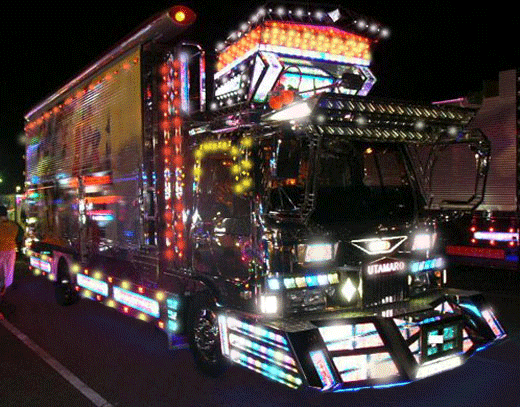Dekotora on:
[Wikipedia]
[Google]
[Amazon]

 , an
, an
Camion
From Geibunsha official website.

 , an
, an abbreviation
An abbreviation (from Latin ''brevis'', meaning ''short'') is a shortened form of a word or phrase, by any method. It may consist of a group of letters or words taken from the full version of the word or phrase; for example, the word ''abbrevia ...
for "decoration truck", are a style of decorated truck
A truck or lorry is a motor vehicle designed to transport cargo, carry specialized payloads, or perform other utilitarian work. Trucks vary greatly in size, power, and configuration, but the vast majority feature body-on-frame construction ...
s in Japan
Japan ( ja, 日本, or , and formally , ''Nihonkoku'') is an island country in East Asia. It is situated in the northwest Pacific Ocean, and is bordered on the west by the Sea of Japan, while extending from the Sea of Okhotsk in the north ...
. Commonly featuring neon
Neon is a chemical element with the symbol Ne and atomic number 10. It is a noble gas. Neon is a colorless, odorless, inert monatomic gas under standard conditions, with about two-thirds the density of air. It was discovered (along with krypton ...
, LED
A light-emitting diode (LED) is a semiconductor Electronics, device that Light#Light sources, emits light when Electric current, current flows through it. Electrons in the semiconductor recombine with electron holes, releasing energy i ...
or ultraviolet light
Ultraviolet (UV) is a form of electromagnetic radiation with wavelength from 10 nm (with a corresponding frequency around 30 PHz) to 400 nm (750 THz), shorter than that of visible light, but longer than X-rays. UV radiation i ...
s, detailed paintjobs and murals, and stainless steel or golden parts (both on the exterior and the interior), dekotora may be created by workers out of their work trucks for fun, or they may be designed by hobbyists for special events. They are sometimes also referred to as .
History
In 1975, Toei released the first in a series of 10 movies called ''Torakku Yarō
is a series of ten Japanese action comedy films produced by Toei and released from 1975 to 1979. All ten films in the series were directed by Norifumi Suzuki and starred Bunta Sugawara as Momojiro Hoshi ("Ichibanboshi" or "first star") and Kinya ...
'' (''Truck Guys''). These films featured truckers who drove garishly decorated trucks around Japan. This movie was a hit with both old and young, and the ''dekotora'' fad swept the country. While ''dekotora'' were present throughout the 1970s, they were restricted to north-eastern fishing transport trucks prior to the movies. In those days, ready-made parts for trucks were not easily available, so these trucks took parts from sightseeing buses or American military vehicles.
Modern times
Since the late 1990s, ''dekotora'' have been heavily influenced by the art ofGundam
is a Japanese military fiction media franchise. Created by Yoshiyuki Tomino and Sunrise (now Bandai Namco Filmworks), the franchise features giant robots, or mecha, with the name "Gundam". The franchise began on April 7, 1979, with ''Mobile ...
. Other decorations are more akin to modern art and retro designs that closely resemble those found in the movie.
Styles
*Kansai
The or the , lies in the southern-central region of Japan's main island Honshu, Honshū. The region includes the Prefectures of Japan, prefectures of Nara Prefecture, Nara, Wakayama Prefecture, Wakayama, Kyoto Prefecture, Kyoto, Osaka Prefectur ...
-style
* Kantō-style
* Retro-style
See also
*Dekochari
The is a form of art bike indigenous to Japan dating back to the mid-1970s. "Deko" in Japanese is short for "decoration" and "chari" is slang for "bike". The ''dekochari'' was a response by children to the Dekotora ("tora" is short for "truck") c ...
, bicycles modelled after ''dekotora''
*Itasha
In Japan, an is a car decorated with images of characters from anime, manga, or video games (especially ''bishōjo'' games or ''eroge''). The decorations usually involve paint schemes and stickers. The cars are seen prominently in places such ...
, cars decorated with anime
is Traditional animation, hand-drawn and computer animation, computer-generated animation originating from Japan. Outside of Japan and in English, ''anime'' refers specifically to animation produced in Japan. However, in Japan and in Japane ...
characters
*Jeepneys
Jeepneys (), sometimes called jeeps (), are minibus-like public utility vehicles, serving as the most popular means of public transportation in the Philippines. They are known for their crowded seating and kitsch decorations, which have become ...
, trucks originally made from surplus American jeeps from WWII, and later being replaced by installing surplus parts from Japan aftermarket.
*Chiva buses
A chiva (Spanish for goat) or ''escalera'' (Spanish for ladder and stairs) is an artisan rustic bus used in rural Colombia. Chivas are adapted to rural public transport, especially considering the mountainous geography of the Andean region of ...
, colourful buses primarily seen in Colombia and Ecuador
* Tap taps, painted Haitian "buses"
*Truck art in South Asia
Truck art in South Asia is a popular form of regional decoration, with trucks featuring elaborate floral patterns and calligraphy. It is especially common in Pakistan and India.
During the War in Afghanistan, Pakistani decorated trucks that ran ...
External links
Camion
From Geibunsha official website.
References
{{portal, art, asia Trucking subculture Art vehicles Japanese subcultures Vehicles of Japan Public art in Japan